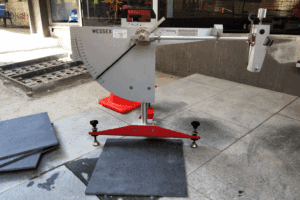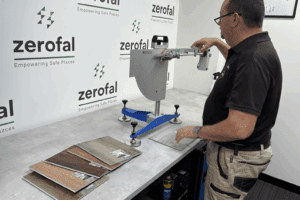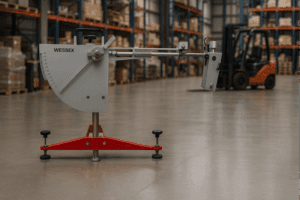From Tile to Certificate: The Lab Journey
- AS 4586:2013 governs slip resistance testing of new surfaces before occupation.
- Zerofal’s lab process includes logging, testing, analysis, and classification.
- Results are issued in NATA-traceable reports suitable for compliance and audit.
For many contractors, the first time they see a slip test report is when it arrives in their inbox. What happens in the lab before that point is less well understood. Yet the process is critical for ensuring results are accurate, repeatable, and compliant with Australian Standards.
Sample Logging and Inspection
When a product arrives at Zerofal’s Sydney lab, it is photographed, labelled, and inspected. Details such as size, texture, and whether the sample has been coated are recorded. This information is essential for selecting the correct test method.
Selecting the Method
AS 4586:2013 defines four test methods, but most products are tested using either the wet pendulum test or the dry floor friction test. The wet pendulum test provides a “P” rating between “P0” and “P5” for surfaces that may be exposed to moisture. The dry floor friction test produces a “D” classification of either “D0” or “D1” for surfaces that are always dry.
Testing in Practice
The wet pendulum test uses the Portable Skid Resistance Tester, while the dry test uses the Tortus 3 floor friction tester. Both devices are calibrated regularly to maintain compliance. For dry testing, multiple test runs are performed on each sample to ensure compliance and traceability.
Analysis and Classification
Results are rounded in accordance with AS 4586:2013. A mean value is calculated and compared against classification tables. Surfaces that meet the thresholds are assigned a P or D classification.
Certification
The final step is the report. Every Zerofal report is NATA-traceable and includes photographs, conditions, and results. This makes it suitable for compliance records, audits, and handovers.
Need certified slip ratings before installation?
Zerofal’s Sydney lab delivers fast, accredited reports nationwide.
Explore more

Colour, Grit and Surface Finish: How Subtle Differences Change Slip Ratings (AS 4586:2013)
Colour, grit and finish change slip resistance. Learn why P-ratings vary across tile ranges and coatings

Why One Slip Test Isn’t Enough for Product Lines (AS 4586:2013)
Slip resistance varies across colours and finishes. Learn why one AS 4586 test cannot certify an entire product line.

Industrial Slip Resistance: Dust, Boots & Coating Drift (AS 4663:2013)
: Industrial floors change fast. Learn how dust, coatings and machinery reduce slip resistance and why AS 4663 onsite testing is essential.
